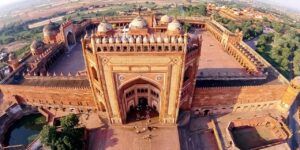
Fatehpur Sikri is a historical city located in the Agra District of the Indian state of Uttar Pradesh. It is renowned for its well-preserved Mughal architecture and served as the capital of the Mughal Empire from 1571 to 1585 during the reign of Emperor Akbar. Here are some basic details about Fatehpur Sikri:
Foundation and Construction:
Fatehpur Sikri was founded in 1569 by Emperor Akbar. The construction of the city took around 15 years, and it was abandoned just 14 years after its completion.
Architectural Style:
The architectural style of Fatehpur Sikri is a blend of various influences, including Persian, Timurid, and Indian styles. The city showcases the cultural and artistic richness of the Mughal era.
Purpose:
Fatehpur Sikri was established to honor the Sufi saint Sheikh Salim Chishti, who had predicted the birth of Akbar’s heir. It was also intended to serve as the Mughal capital, but due to water shortages, the capital was later shifted to Lahore.
Structures and Monuments:
Some of the notable structures within Fatehpur Sikri include:
Buland Darwaza: A grand gateway built to commemorate Akbar’s victory over Gujarat.
Jama Masjid: A large mosque with intricate carvings and a central courtyard.
Diwan-i-Khas: A hall for private audiences adorned with a central pillar.
Panch Mahal: A five-story palace with a unique architectural design.
Jodha Bai Palace: Believed to be the residence of Akbar’s Rajput queen, Jodha Bai.
Religious Diversity:
Fatehpur Sikri reflects Akbar’s efforts to promote religious harmony. The city includes structures of various religious significance, such as the Jama Masjid, the Tomb of Salim Chishti, and a Christian cemetery.
Abandonment:
Fatehpur Sikri was abandoned in 1585, just 14 years after its completion, primarily due to the scarcity of water in the region. The Mughal capital was subsequently shifted to Lahore.
UNESCO World Heritage Site:
In 1986, Fatehpur Sikri was designated as a UNESCO World Heritage Site, recognizing its cultural and historical significance
